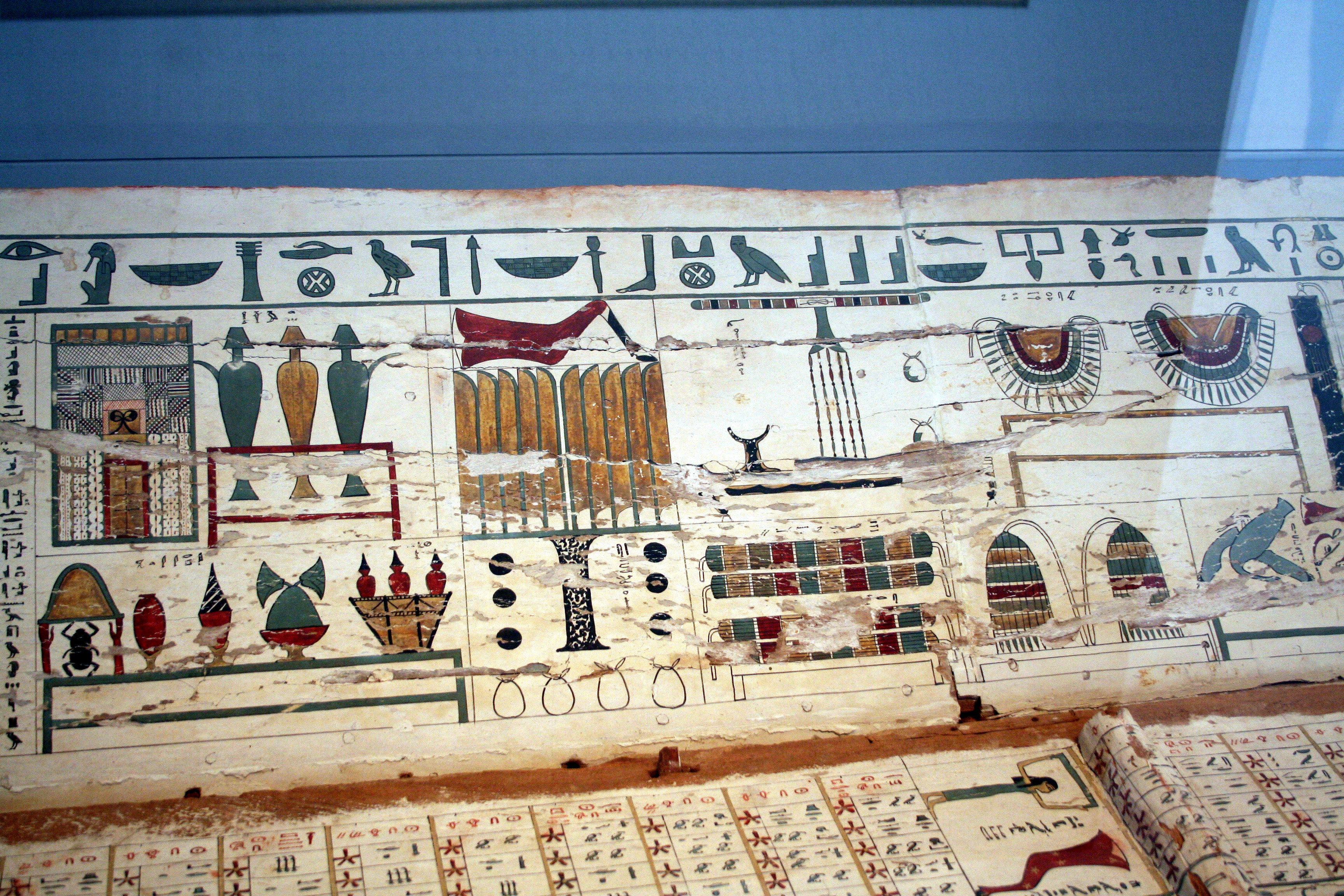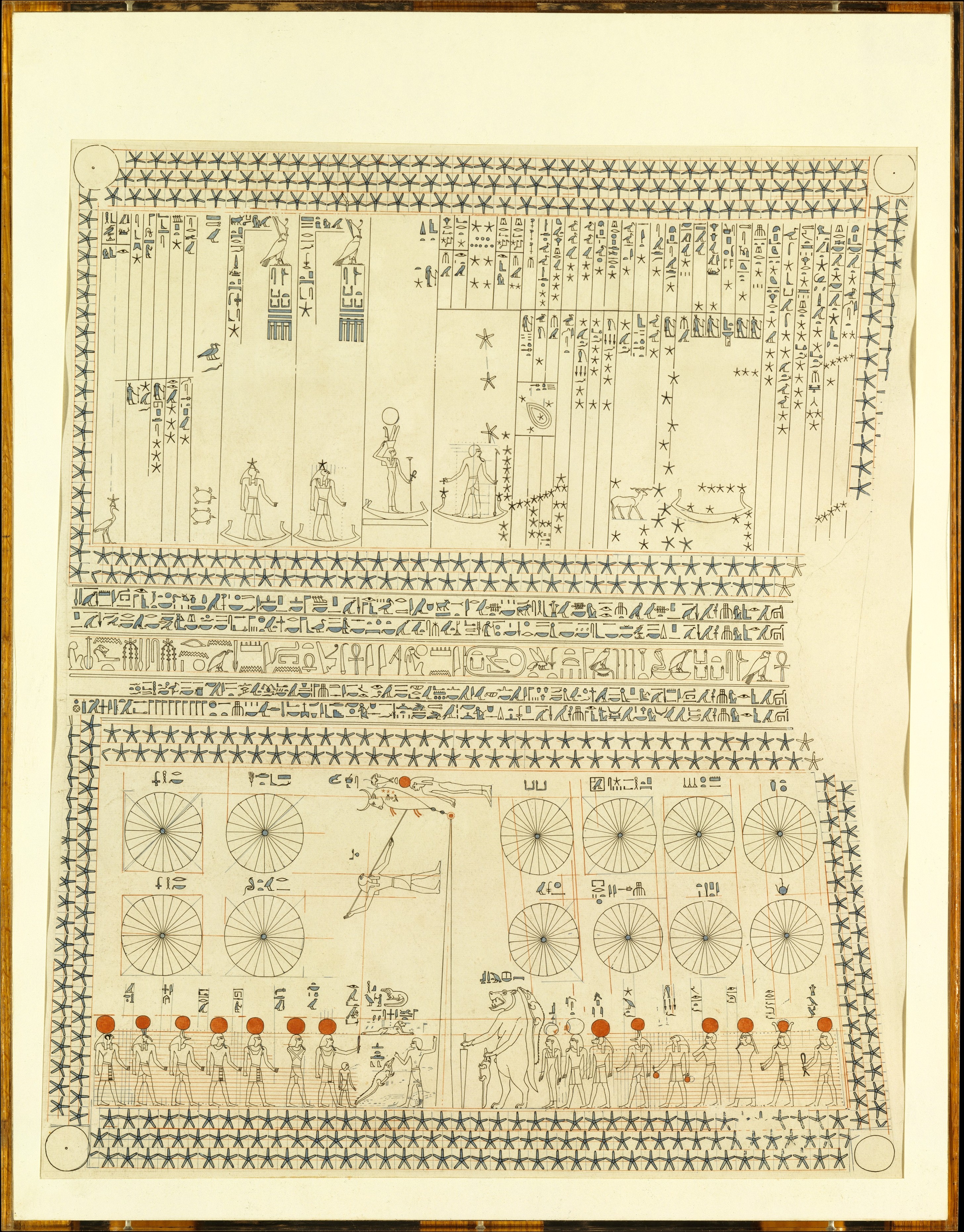|
Decans
The decans (; Egyptian ''bꜣktw'' or ''baktiu'', " hoseconnected with work") are 36 groups of stars (small constellations) used in the ancient Egyptian astronomy to conveniently divide the 360 degree ecliptic into 36 parts of 10 degrees each, both for theurgical and heliacal horological purposes. The decans each appeared, geocentrically, to rise consecutively on the horizon throughout each daily earth rotation. The rising of each ''decan'' marked the beginning of a new decanal "hour" (Greek ''hōra'') of the night for the ancient Egyptians, and they were used as a sidereal star clock beginning by at least the 9th or 10th Dynasty (c. 2100 BCE). Because a new decan also appears heliacally every ten days (that is, every ten days, a new decanic star group reappears in the eastern sky at dawn right before the Sun rises, after a period of being obscured by the Sun's light), the ancient Greeks called them ''dekanoi'' (δεκανοί; pl. of δεκανός ''dekanos'') or "tenths". ... [...More Info...] [...Related Items...] OR: [Wikipedia] [Google] [Baidu] |
Decan (astrology)
In astrology, a ''decan'' is the subdivision of a sign. In order to give fuller interpretation to the zodiac signs, ancient astrologers subdivided each sign into periods of approximately ten days. These divisions are known as the "decans" or "decantes" and cover modifications of individual traits, attributed to minor planetary influences, which temper or blend with the ruling influence of the period. The ten-day spans are somewhat arbitrary in order to allow for the five (and sometimes six) extra days in the year beyond the 360 days required for the thirty-six decans. In modern times, however, the assignment of decans has changed considerably. Each sign is allocated a triplicity, consisting of three of the four classical elements air, water, earth or fire, and is therefore subdivided into three equal parts of 10 degrees each; these parts are referred to as ''decans'' or ''decanates''. Each decan of a sign is assigned rulership by the planet ruling the sign and secondary rulersh ... [...More Info...] [...Related Items...] OR: [Wikipedia] [Google] [Baidu] |
Hellenistic Astrology
Hellenistic astrology is a tradition of horoscopic astrology that was developed and practiced in the late Hellenistic period in and around the Mediterranean Basin region, especially in Egypt. The texts and technical terminology of this tradition of astrology were largely written in Greek (or sometimes Latin). The tradition originated sometime around the late 2nd or early 1st century BCE, and then was practiced until the 6th or 7th century CE. This type of astrology is commonly referred to as "Hellenistic astrology" because it was developed in the late Hellenistic period, although it continued to be practiced for several centuries after the end of what historians usually classify as the Hellenistic era. The scientific consensus is that Hellenistic astrology is a pseudoscience . History The origins of much of the astrology that would later develop in Asia, Europe and the Middle East are found among the ancient Babylonians and their system of celestial omens that began to be comp ... [...More Info...] [...Related Items...] OR: [Wikipedia] [Google] [Baidu] |
Egyptian Astronomy
Egyptian astronomy began in prehistoric times, in the Predynastic Period. In the 5th millennium BCE, the stone circles at Nabta Playa may have made use of astronomical alignments. By the time the historical Dynastic Period began in the 3rd millennium BCE, the 365 day period of the Egyptian calendar was already in use, and the observation of stars was important in determining the annual flooding of the Nile. The Egyptian pyramids were carefully aligned towards the pole star, and the temple of Amun-Re at Karnak was aligned on the rising of the midwinter Sun. Astronomy played a considerable part in fixing the dates of religious festivals and determining the hours of night, and temple astrologers were especially adept at watching the stars and observing the conjunctions and risings of the Sun, Moon, and planets, as well as the lunar phases. In Ptolemaic Egypt, the Egyptian tradition merged with Greek astronomy and Babylonian astronomy, with the city of Alexandria in Lower ... [...More Info...] [...Related Items...] OR: [Wikipedia] [Google] [Baidu] |
Heliacal Rising
The heliacal rising ( ) or star rise of a star occurs annually, or the similar phenomenon of a planet, when it first becomes visible above the eastern horizon at dawn just before sunrise (thus becoming "the morning star") after a complete orbit of the earth around the sun. Historically, the most important such rising is that of Sirius, which was an important feature of the Egyptian calendar and astronomical development. The rising of the Pleiades heralded the start of the Ancient Greek sailing season, using celestial navigation. Cause and significance Relative to the stars, the sun appears to drift eastward about one degree per day along a path called the ecliptic because there are 360 degrees in any complete revolution (circle), which takes about 365 days in the case of one revolution of the earth around the sun. Any given "distant" star in the belt of the ecliptic will be visible at night for only half of the year, when it will always remain below the horizon. During the ... [...More Info...] [...Related Items...] OR: [Wikipedia] [Google] [Baidu] |
Hour
An hour (symbol: h; also abbreviated hr) is a unit of time conventionally reckoned as of a day and scientifically reckoned between 3,599 and 3,601 seconds, depending on the speed of Earth's rotation. There are 60 minutes in an hour, and 24 hours in a day. The hour was initially established in the ancient Near East as a variable measure of of the night or daytime. Such seasonal, temporal, or unequal hours varied by season and latitude. Equal or equinoctial hours were taken as of the day as measured from noon to noon; the minor seasonal variations of this unit were eventually smoothed by making it of the mean solar day. Since this unit was not constant due to long term variations in the Earth's rotation, the hour was finally separated from the Earth's rotation and defined in terms of the atomic or physical second. In the modern metric system, hours are an accepted unit of time defined as 3,600 atomic seconds. However, on rare occasions an hour may incorporate a positive ... [...More Info...] [...Related Items...] OR: [Wikipedia] [Google] [Baidu] |
Heliacal Rising
The heliacal rising ( ) or star rise of a star occurs annually, or the similar phenomenon of a planet, when it first becomes visible above the eastern horizon at dawn just before sunrise (thus becoming "the morning star") after a complete orbit of the earth around the sun. Historically, the most important such rising is that of Sirius, which was an important feature of the Egyptian calendar and astronomical development. The rising of the Pleiades heralded the start of the Ancient Greek sailing season, using celestial navigation. Cause and significance Relative to the stars, the sun appears to drift eastward about one degree per day along a path called the ecliptic because there are 360 degrees in any complete revolution (circle), which takes about 365 days in the case of one revolution of the earth around the sun. Any given "distant" star in the belt of the ecliptic will be visible at night for only half of the year, when it will always remain below the horizon. During the ... [...More Info...] [...Related Items...] OR: [Wikipedia] [Google] [Baidu] |
Sarg Des Nacht 3 (1880–1942), German-American puppeteer and illustrator
{{disambiguation, surname ...
Sarg may refer to: * Charles Sprague Sargent (1841–1927), American botanist (standard abbreviation for his name is "Sarg.") * SARG — Syrian Arab Republic Government * Searchable Arguments in the WHERE clause of a SQL database query. * SARG04, a quantum key distribution protocol People with the surname *Tony Sarg Anthony Frederick Sarg (April 21, 1880–March 7, 1942), known professionally as Tony Sarg, was a German American puppeteer and illustrator. He was described as "America's Puppet Master", and in his biography as the father of modern puppetry ... [...More Info...] [...Related Items...] OR: [Wikipedia] [Google] [Baidu] |
Calendar
A calendar is a system of organizing days. This is done by giving names to periods of time, typically days, weeks, months and years. A date is the designation of a single and specific day within such a system. A calendar is also a physical record (often paper) of such a system. A calendar can also mean a list of planned events, such as a court calendar or a partly or fully chronological list of documents, such as a calendar of wills. Periods in a calendar (such as years and months) are usually, though not necessarily, synchronized with the cycle of the sun or the moon. The most common type of pre-modern calendar was the lunisolar calendar, a lunar calendar that occasionally adds one intercalary month to remain synchronized with the solar year over the long term. Etymology The term ''calendar'' is taken from , the term for the first day of the month in the Roman calendar, related to the verb 'to call out', referring to the "calling" of the new moon when it was first se ... [...More Info...] [...Related Items...] OR: [Wikipedia] [Google] [Baidu] |
Dover Publications
Dover Publications, also known as Dover Books, is an American book publisher founded in 1941 by Hayward and Blanche Cirker. It primarily reissues books that are out of print from their original publishers. These are often, but not always, books in the public domain. The original published editions may be scarce or historically significant. Dover republishes these books, making them available at a significantly reduced cost. Classic reprints Dover reprints classic works of literature, classical sheet music, and public-domain images from the 18th and 19th centuries. Dover also publishes an extensive collection of mathematical, scientific, and engineering texts. It often targets its reprints at a niche market, such as woodworking. Starting in 2015, the company branched out into graphic novel reprints, overseen by Dover acquisitions editor and former comics writer and editor Drew Ford. Most Dover reprints are photo facsimiles of the originals, retaining the original pagination and ... [...More Info...] [...Related Items...] OR: [Wikipedia] [Google] [Baidu] |
Vettius Valens
Vettius Valens (120 – c. 175) was a 2nd-century Hellenistic astrologer, a somewhat younger contemporary of Claudius Ptolemy. Valens' major work is the ''Anthology'' ( la, Anthologia), ten volumes in Greek written roughly within the period 150 to 175. The ''Anthology'' is the longest and most detailed treatise on astrology which has survived from that period. A working professional astrologer, Valens includes over a hundred sample charts from his case files in the ''Anthology''. Travels Although originally a native of Antioch, he appears to have travelled widely in Egypt in search of specific astrological doctrines to bolster his practice. At the time Alexandria was still home to a number of astrologers of the older Babylonian, Greek and Egyptian traditions. He published much of what he learned from the tradition and through his practice in his ''Anthology'', written in an engaging and instructional style. The ''Anthology'' is thus of great value in piecing together actual ... [...More Info...] [...Related Items...] OR: [Wikipedia] [Google] [Baidu] |




_MET_DP-13486-011.jpg)